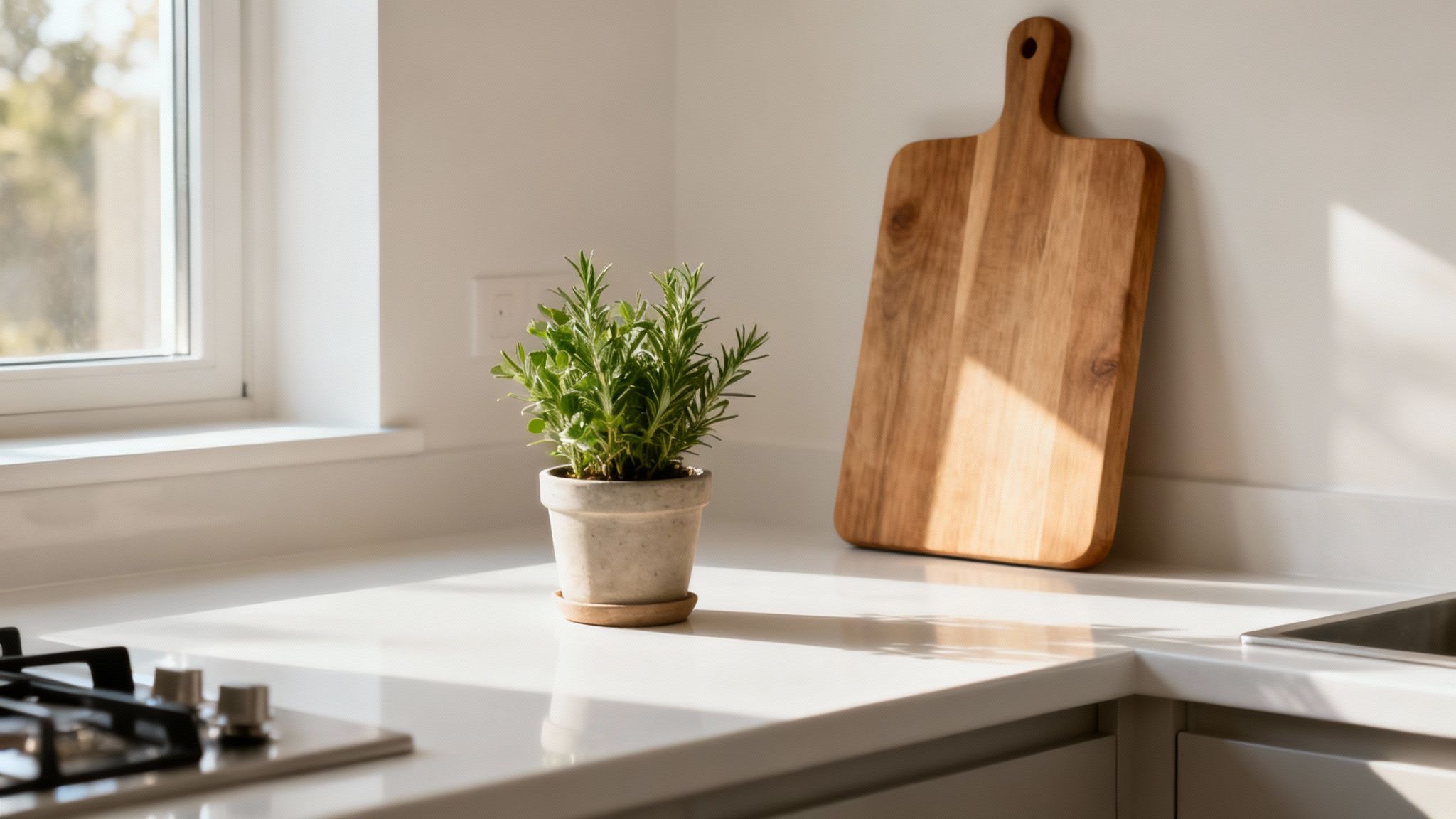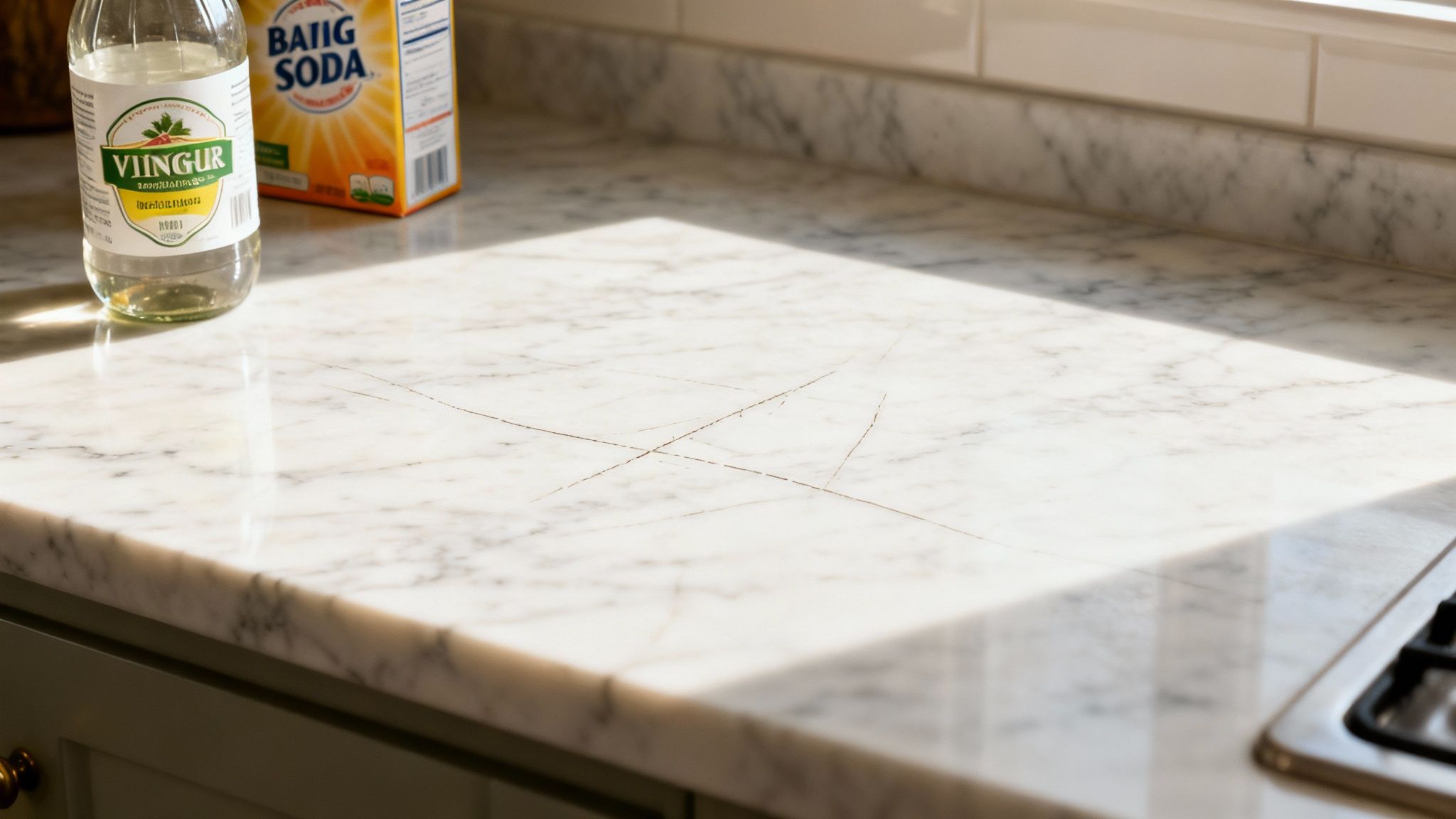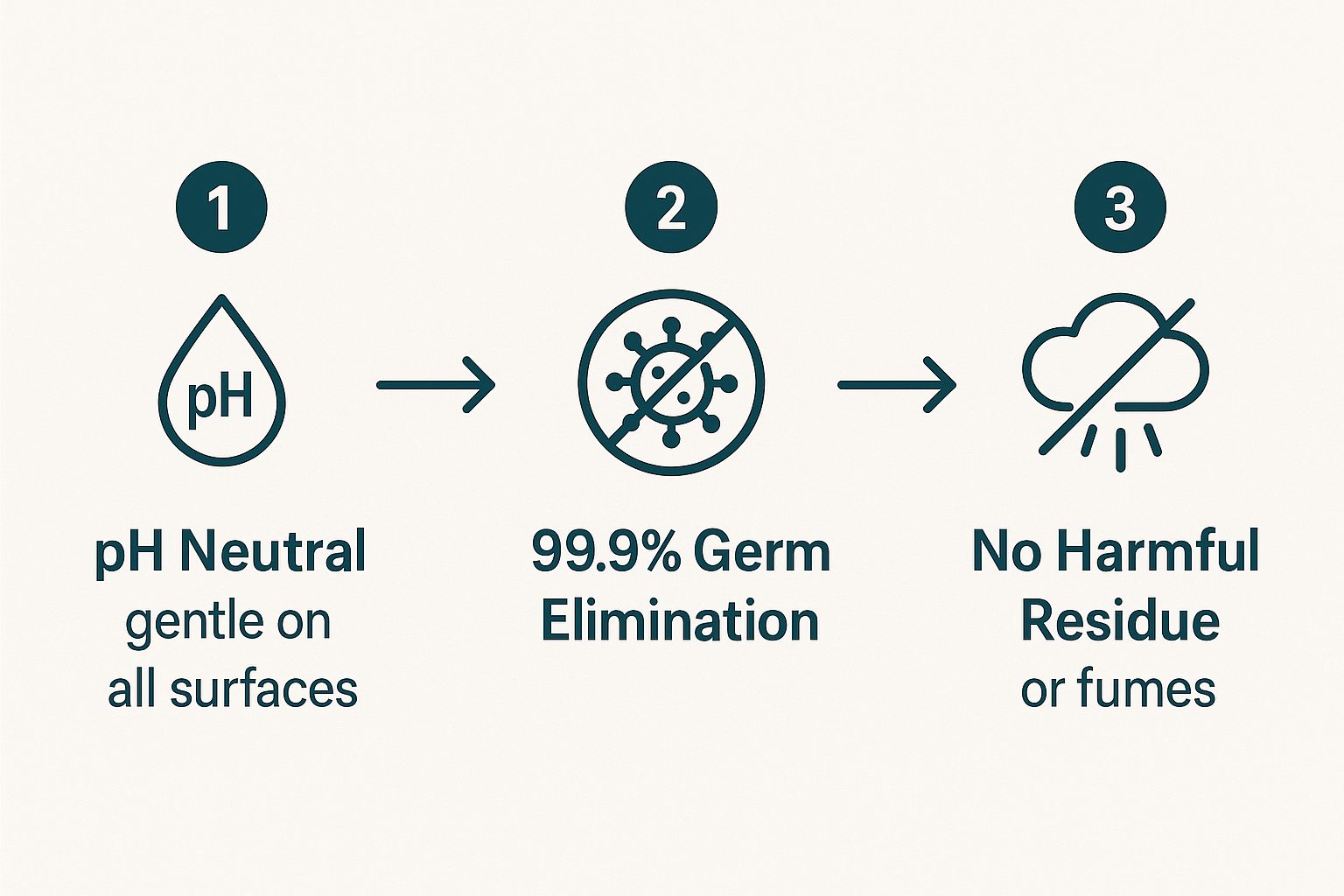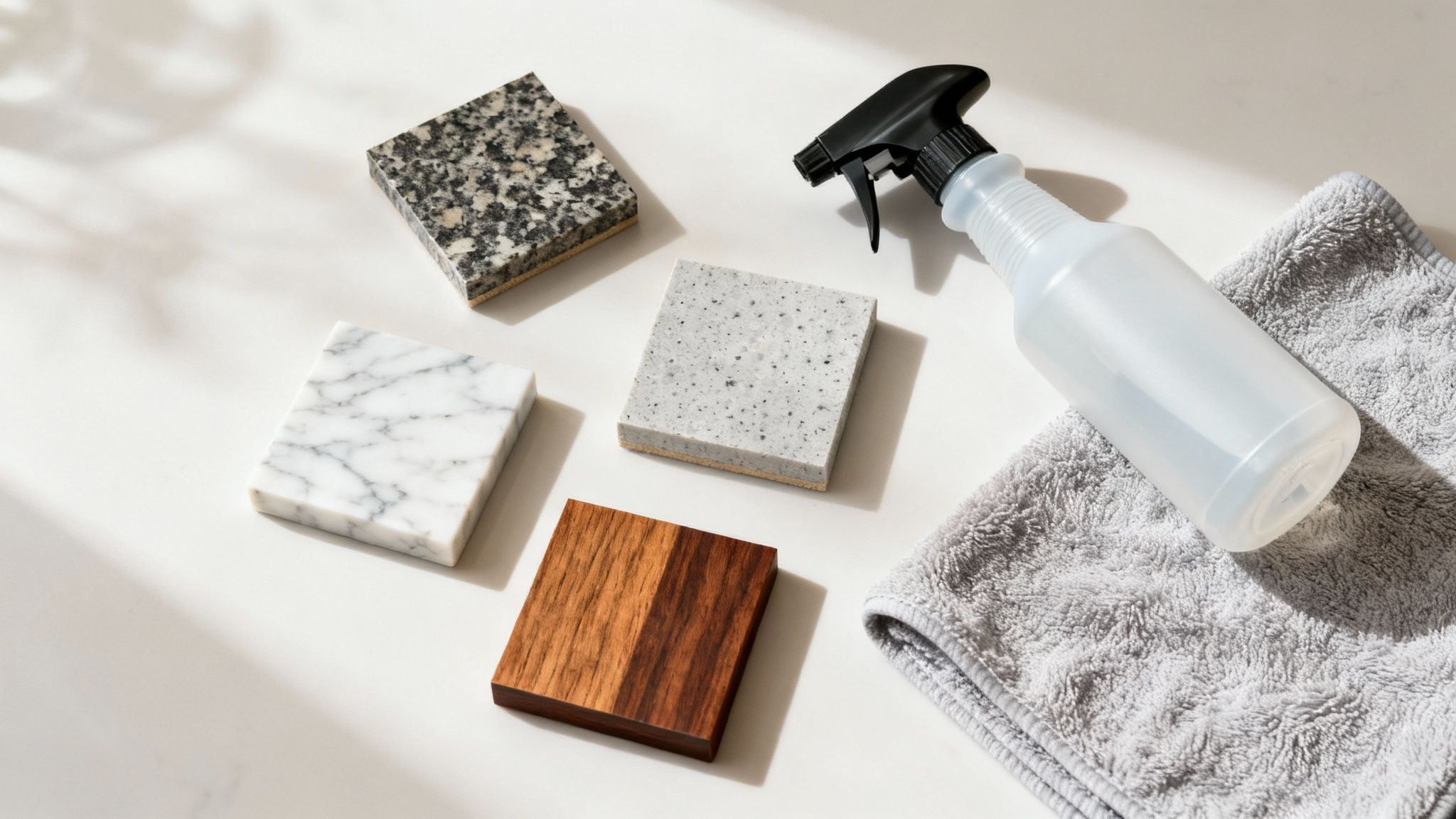Maintaining a clean kitchen countertop is a simple, everyday task. First, brush away loose crumbs with a dry cloth. Then, apply a gentle, residue-free cleaner and wipe the surface with a fresh microfiber towel. This approach ensures your food preparation area remains clean and ready for use, without harsh chemicals. Here’s how to clean safely and simply.
Creating a Clean, Safe Kitchen Environment

The kitchen counter is more than a utility surface; it is the center of the home. It is where you prepare meals, share conversations, and create memories with family. The desire to keep this space clean comes from a fundamental need to care for our loved ones.
The choice of cleaner is therefore significant. A truly clean surface is not just about appearance. It is about the peace of mind that comes from knowing food prep areas are free from chemical residues. A simple, effective routine supports this feeling of well-being for your family and pets.
The Foundation of a Well-Kept Home
Achieving a deep clean can be challenging. Many common household cleaners can leave behind unwanted substances on surfaces. Studies often show that countertops may not be as clean as they appear after a standard wipe-down.
This has led many people to seek a better way to clean. The goal is a method that provides confidence without complicated steps or harsh ingredients.
A well-kept home is a space that feels calm and genuinely cared for. This is especially true where your family gathers to eat. You should not have to second-guess what is left behind on your surfaces.
To create an immaculate kitchen, this feeling should extend beyond countertops. Learning the best way to clean wood kitchen cabinets helps maintain a consistently clean environment throughout the heart of your home.
Common Missteps in Kitchen Cleaning

Many people associate powerful smells, like bleach or ammonia, with effective cleaning. For decades, this has been a common assumption. However, conventional cleaners can introduce new concerns into the home. They often leave more behind than just a clean surface.
Strong fragrances and chemical residues can linger where you prepare food. These substances may irritate sensitive skin or airways. The purpose of cleaning is to remove grime, not to replace it with a different kind of concern.
The Pitfalls of Popular DIY Solutions
DIY cleaners seem like a simple alternative, but they have their own drawbacks. While common pantry items appear harmless, they can cause issues.
- Vinegar: Its acidity is useful for some tasks but can damage others. On natural stone like marble or granite, it can etch the surface and dull its finish.
- Baking Soda: As a gentle abrasive, it can be effective. Over time, however, it may create micro-scratches on delicate surfaces like laminate or polished stone.
- Essential Oils: While they provide pleasant scents, many oils are not food-safe. They can leave behind a sticky film that attracts more dust and grime.
Understanding the trade-offs is important. A method that works on one countertop can damage another. Finding a solution that is both effective and gentle on multiple surfaces simplifies home care.
Knowing how to clean kitchen countertops involves matching the right method to the material. A truly simple approach should work safely across your entire kitchen.
A Simple Cleaning Approach Rooted in Science
It is possible to clean countertops effectively without harsh chemicals. A better way exists, grounded in gentle science. The answer is a compound called Hypochlorous Acid (HOCl). While the name sounds technical, the concept is simple. HOCl is the same substance the human immune system creates to stay healthy.
This science-backed solution cleans powerfully without leaving behind harsh residues or strong fragrances. It helps create a truly clean surface, perfect for homes with children, pets, or sensitive individuals. It is a way to maintain your kitchen with confidence.
The Science of Gentle Cleaning
The effectiveness of HOCl lies in its simplicity. It is made from three basic components: water, salt, and electricity. This process creates a cleaner that leaves nothing behind after use.
This straightforward approach supports a calm, healthy home without conventional chemical worries. You can learn more about the science behind safe cleaning with our in-depth guide to HOCl.

The image illustrates how a pH-neutral formula can be gentle on surfaces. This combination provides genuine peace of mind, leaving your home free of unwanted residues.
This approach shifts the focus from harsh chemicals to simple science. It is about achieving a pristine clean that works with your home’s environment, not against it.
A modern, science-based approach means you no longer have to choose between safe and effective.
Your Guide to Cleaning Countertops

Cleaning your kitchen countertops effectively comes down to understanding the surface. Different materials require slightly different care, but the process remains simple. A gentle, residue-free cleaner allows you to maintain a consistent clean across most common surfaces.
For daily maintenance, the approach is nearly always the same. First, wipe away crumbs with a dry cloth. Then, lightly mist the surface with your cleaner and wipe it down with a microfiber cloth. This two-step process is all that is needed to keep surfaces looking their best.
A Quick Look at Different Countertop Materials
While a daily wipe-down is straightforward, each material has unique properties. Understanding them helps keep your countertops looking beautiful for years.
- Granite and Marble: These porous stones are sensitive to acidic substances. Spills like wine or citrus juice should be wiped up promptly to prevent etching. Always use a pH-neutral cleaner to protect the sealant. For more detail, this guide on how to safely and effectively clean natural stone surfaces is a helpful resource.
- Quartz: As a non-porous engineered stone, quartz is easy to maintain. It is highly resistant to stains and very durable. Simply spray and wipe; it does not require special sealants.
- Laminate: This material can be scratched by abrasive cleaners. To avoid dulling the finish, use soft cloths and gentle, liquid-based solutions.
- Butcher Block: Wood surfaces need care to prevent them from drying out. After cleaning, ensure the surface is completely dry. Regular conditioning with a food-safe oil is key to keeping the wood healthy.
Here is a quick-reference table for your convenience.
Cleaning Guide for Common Countertop Materials
| Countertop Material | Cleaning Method | Important Considerations |
|---|---|---|
| Granite & Marble | Spray a pH-neutral cleaner; wipe with microfiber. | Immediately clean acidic spills (wine, citrus). Avoid vinegar. |
| Quartz | Spray any gentle cleaner; wipe with microfiber. | Highly durable and stain-resistant. No sealant needed. |
| Laminate | Spray a gentle cleaner; wipe with a soft cloth. | Avoid abrasive scrubs or powders that can cause scratches. |
| Butcher Block | Spray a gentle cleaner; wipe and dry thoroughly. | Condition regularly with food-safe oil to prevent cracking. |
Ultimately, a trusted routine is what matters most for a clean and welcoming kitchen.
Keeping It Simple Every Day
Simple, gentle cleaning methods are increasingly popular. Daily wipe-downs with a mild cleaner are effective for most surfaces. Drying with a microfiber cloth afterward helps prevent streaks and water spots.
This minimalist approach keeps your kitchen consistently clean. Once you have a simple routine for countertops, you can apply the same principles elsewhere. Our guide on a good cleaner for stainless steel shows how this philosophy works for appliances.
A Clean and Calm Kitchen
Choosing how to clean your countertops is about more than just spills. It is about creating a home that feels calm and safe for your family. When you find a cleaning method you trust, that confidence is reflected in your home.
This assurance comes from simplicity. A single, effective cleaner that works on different surfaces removes the guesswork from your routine. No more wondering about the chemicals left behind on food-prep areas.
Peace of Mind in Every Wipe
The benefit of a modern, science-backed approach is in what it avoids. By skipping harsh ingredients, you achieve a clean kitchen without overpowering artificial fragrances. This is especially helpful for homes with small children, pets, or sensitive individuals.
A residue-free clean means your countertops are simply clean. Nothing more, nothing less. It supports a healthier home environment. For those who prioritize well-being, exploring hypoallergenic cleaning products can offer more ways to build a gentle routine.
True cleanliness is the quiet confidence that comes from knowing your home is cared for with simple, effective, and thoughtful solutions. It is not about harsh chemicals.
This simple shift creates a space where your family can gather with peace of mind. Luma Living’s approach is built on providing simple, science-backed solutions that support a healthier home.
Still Have Questions About Cleaning?
Changing a cleaning routine can bring up questions. It is natural to want to be sure you are making the right choice for your home. Let’s address some of the most common ones.
Is a Gentle Cleaner Enough for Raw Meat Prep?
After preparing raw meat, you want to know the counter is truly clean. Peace of mind is essential. Cleaning is the critical first step. You must physically remove the grime, oils, and food particles from the surface.
A thorough wipe-down with a simple, effective cleaner like HOCl does exactly that. It lifts and removes debris from the surface, creating a clean slate without chemical residues. This focus on physical removal provides a confident clean.
How Often Should I Be Wiping Down My Counters?
A quick daily wipe-down is very effective. It acts as a reset for your kitchen at the end of the day. This simple habit prevents grime from building up and stops small spills from becoming larger messes.
Of course, you should always clean up immediately after preparing food or after any significant spill. A gentle, all-purpose cleaner makes frequent cleaning feel effortless.
A consistent, simple routine is more effective than occasional deep cleaning. The goal is to maintain a baseline of clean that fits your family’s daily life.
Can I Use This on Other Surfaces Besides My Countertops?
Yes. That is a primary benefit of using a simple, pH-neutral, and residue-free cleaner. It is incredibly versatile and will likely become your go-to for many non-porous surfaces.
It is useful for items like:
- Highchair trays and toys
- Stainless steel appliances
- Bathroom sinks and fixtures
- Pet food and water bowls
This adaptability simplifies things. Instead of a cabinet full of specialized bottles, you can rely on one trusted solution to care for your home.
At Luma Living, we believe a clean home should support your family's well-being. Our science-backed HOCl cleaner offers a simple, effective, and residue-free solution for the surfaces in your home. Discover the Luma Living difference today.



